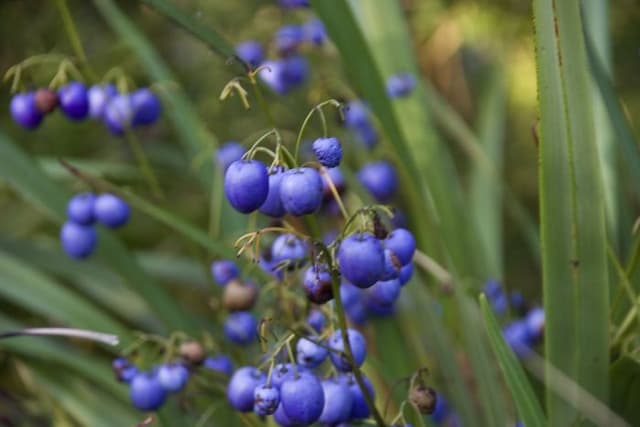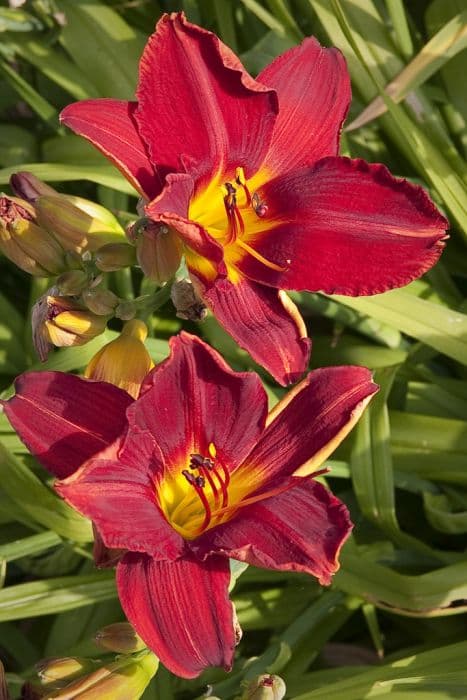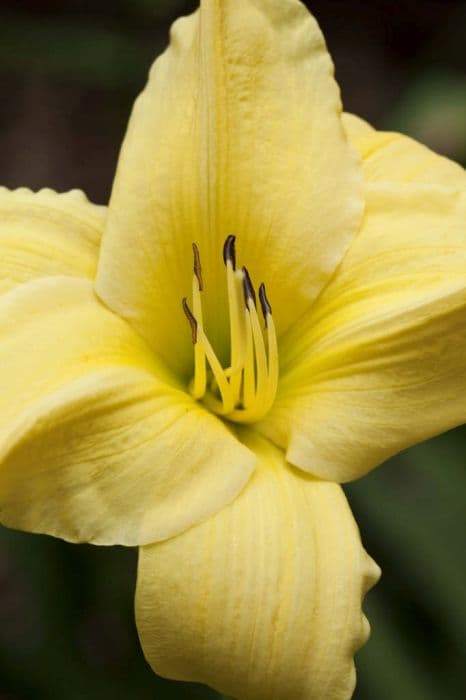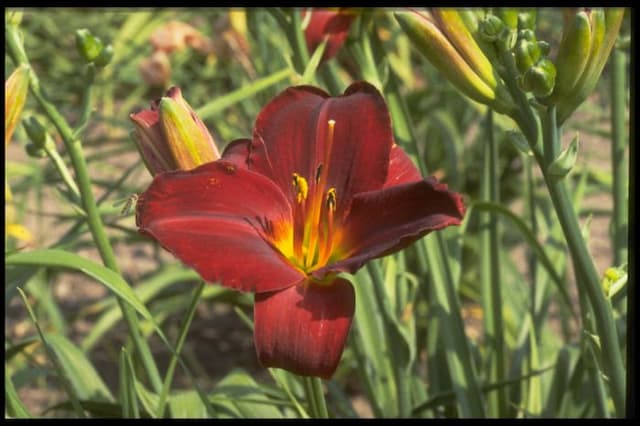Daylily Hemerocallis 'Joan Senior'

ABOUT
Joan Senior is a daylily known for its stunning visual appeal. This perennial plant is a garden favorite due to its large, graceful flowers. It displays a remarkable floral display that catches the eye, featuring blooms that are pure white in color, sometimes described as a near-white or creamy white, with a faint hint of cream or yellow at the throat, which adds a subtle contrast to the petals. The flowers of the Joan Senior are characteristically trumpet-shaped, a signature look of daylilies, which unfurl elegantly from their bud form. The petals exhibit a gentle ruffling along their edges, giving them a delicately textured appearance that enhances the flower's overall beauty. The foliage of Joan Senior forms a dense clump, consisting of long, slender leaves that are a rich, bright green. These leaves arch gracefully and provide a lush background that compliments the purity of the blooms. The leaves and flowers both grow directly from fleshy, tuberous roots which store nutrients and water, thus allowing the plant to be relatively drought-tolerant once established. The Joan Senior is known to be a re-blooming variety, offering gardeners multiple displays of its white flowers throughout the growing season, which truly sets it apart from other daylilies that may only bloom once. The interesting contrast of the creamy blooms against the deep green foliage creates an eye-catching display in any garden setting.
About this plant
 Names
NamesFamily
Hemerocallidaceae
Synonyms
Daylily
Common names
Hemerocallis 'Joan Senior'.
 Toxicity
ToxicityTo humans
The plant commonly known as the daylily, specifically Hemerocallis 'Joan Senior', is not generally considered toxic to humans. Many parts of daylilies are actually edible and are consumed in various cultures. However, it is crucial to correctly identify the plant because some other lily species can be highly toxic. Eating the wrong plant could lead to severe symptoms like vomiting, diarrhea, abdominal pain, and even kidney failure. It's always best to consult with a professional before consuming any part of a plant if you are not absolutely certain about its identity and edibility.
To pets
Daylilies, including Hemerocallis 'Joan Senior', are toxic to cats and potentially harmful to dogs. Ingestion can cause a severe, potentially life-threatening reaction in cats. Symptoms of daylily poisoning in cats can include vomiting, lethargy, kidney failure, and in severe cases, death. While not as toxic to dogs, ingestion can still lead to mild gastrointestinal upset. Cats should never be allowed to nibble on any part of a daylily. Any suspected ingestion should prompt immediate veterinary attention.
 Characteristics
CharacteristicsLife cycle
Perennials
Foliage type
Deciduous
Color of leaves
Green
Flower color
White
Height
2 feet (60 cm)
Spread
2 feet (60 cm)
Plant type
Herb
Hardiness zones
3
Native area
Asia
Benefits
 General Benefits
General Benefits- Ornamental Appeal: Hemerocallis 'Joan Senior', commonly known as Daylily, adds striking visual interest to gardens with its large, creamy white flowers.
- Drought Tolerance: Daylilies are known for their ability to withstand dry conditions once established, making them suitable for xeriscaping.
- Easy to Grow: They are relatively low-maintenance, adaptable to a range of soils, and easy to cultivate, which is ideal for novice gardeners.
- Pest Resistance: These plants are resistant to many pests, reducing the need for chemical treatments.
- Long Blooming Season: Daylilies produce flowers for an extended period, often blooming from early summer to fall, offering long-lasting color.
- Attracts Pollinators: The vibrant flowers attract bees, butterflies, and other pollinators, which are vital for the health of the ecosystem.
- Erosion Control: The robust root system of Daylilies can help stabilize soil and prevent erosion.
- Variety of Uses: They can be used in borders, flower beds, and as ground cover, adding versatility to landscaping projects.
- Propagates Easily: Daylilies can be easily divided to create more plants, making them cost-effective and great for sharing with others.
- Non-Invasive: Unlike some other perennials, Daylilies spread slowly and are not considered invasive, making garden management easier.
 Medical Properties
Medical PropertiesThis plant is not used for medical purposes.
 Air-purifying Qualities
Air-purifying QualitiesThis plant is not specifically known for air purifying qualities.
 Other Uses
Other Uses- Art and Craft Supplies: The white petals of the daylily 'Joan Senior' can be pressed and used in floral art projects, scrapbooking, or to create natural decorations.
- Educational Tool: Educators can use daylilies in lessons about plant biology, hybridization, and horticulture due to their variety of colors and ease of growth.
- Culinary Garnishes: The large, attractive blooms can serve as edible garnishes for salads and desserts, adding a touch of elegance to dishes.
- Natural Fabric Dye: The petals and other parts of the daylily can be used to create natural dyes for coloring textiles.
- Photography Subject: The beauty and distinctiveness of the 'Joan Senior' daylily make it an ideal subject for photography enthusiasts, especially for macro photography.
- Garden Design and Landscaping: Daylilies can be used as border plants or for mass planting due to their clumping nature and visual appeal.
- Composting Material: After bloom, daylilies can be added to compost bins to create nutrient-rich compost for gardens and potted plants.
- Erosion Control: The root systems of daylilies help stabilize soil, making them useful in preventing erosion on slopes and banks.
- Nature-Inspired Decor: The stunning white blooms can be used to inspire designs and patterns for interior decor items like cushions, wallpapers, or curtains.
- Wedding Decor: Fresh or dried daylilies can be incorporated into wedding bouquets, centerpieces, and venue decorations for a natural, rustic theme.
Interesting Facts
 Feng Shui
Feng ShuiThe Daylily is not used in Feng Shui practice.
 Zodiac Sign Compitability
Zodiac Sign CompitabilityThe Daylily is not used in astrology practice.
 Plant Symbolism
Plant Symbolism- Beauty and Grace: The Hemerocallis 'Joan Senior,' commonly known as the Daylily, is admired for its elegant appearance and lovely blooms, which symbolize beauty and grace.
- Embracing Change: Daylilies bloom for just one day, reminding us to embrace change and the fleeting nature of life's beautiful moments.
- Motherhood: In Chinese culture, daylilies represent motherhood and the nurturing aspects because of their prolific nature and ability to thrive in various conditions.
- Renewal: As each day brings a new flower, daylilies are symbolic of renewal and the opportunity to start anew.
- Forgiveness: Linked to the ephemeral nature of the blooms, daylilies can symbolize an attitude of letting go and forgiving, akin to the flowers' brief but significant life span.
 Water
WaterDaylilies, including Hemerocallis 'Joan Senior', prefer consistent moisture, especially during the growing season. Water the plant deeply once a week, providing about an inch of water which is equivalent to approximately 0.6 gallons per square yard of soil. It is important to avoid overhead watering to prevent leaf spot diseases. In the absence of rainfall, increase watering frequency. Be cautious not to overwater, as daylilies do not like to sit in waterlogged soil which can lead to root rot.
 Light
LightDaylilies, such as the Hemerocallis 'Joan Senior', thrive in full sun to partial shade. The optimal location is where the plant can receive at least six hours of sunlight a day. Avoid deep shade as it can lead to fewer blooms and a less vigorous plant.
 Temperature
TemperatureDaylilies, like Hemerocallis 'Joan Senior', are very adaptable but grow best with temperatures between 60°F and 75°F. They can survive cold winter temperatures down to about -30°F and can tolerate summer heat up to 90°F. These temperature ranges make daylilies suitable for a wide range of climates.
 Pruning
PruningDaylilies, such as the Hemerocallis 'Joan Senior', benefit from deadheading spent flowers regularly to encourage more blooms. After flowering, cut back the flower stalks to the base. In late fall, prune back any dead or damaged foliage to keep the plant tidy. Divide clumps every 3 to 5 years to maintain vigor.
 Cleaning
CleaningAs needed
 Soil
SoilThe best soil mix for the Daylily 'Joan Senior' is well-draining, fertile, and slightly acidic to neutral, with pH ranging between 6.0 and 7.0. A mixture containing loamy garden soil, compost, and a bit of sand or perlite to improve drainage works well for this plant.
 Repotting
RepottingDaylilies, including 'Joan Senior', don't require frequent repotting and do well when left undisturbed for several years. They may only need repotting every 3 to 5 years, or when the clump becomes overcrowded and flowering diminishes.
 Humidity & Misting
Humidity & MistingDaylilies such as 'Joan Senior' are not particularly humidity-sensitive and can thrive in a wide range of humidity levels, but they generally prefer moderate ambient humidity.
 Suitable locations
Suitable locationsIndoor
Provide bright light, well-drained soil, minimal watering.
Outdoor
Full sun to partial shade, well-drained soil, moderate watering.
Hardiness zone
3-9 USDA
 Life cycle
Life cycleDaylily 'Joan Senior' begins its life cycle as a seed, which, once sown, germinates to produce a small sprout. The sprout develops into a juvenile plant with strap-like foliage and as it matures, it forms a clump of leafy growth with strong roots. Each year, typically in late spring to early summer, it enters a flowering stage where it produces large, trumpet-shaped, creamy white blossoms that last just one day each, hence the name "daylily." After flowering, seed pods may form, which can be harvested for propagation or left to self-seed in the garden. As the growth season ends, the foliage may die back, especially in colder climates, entering a period of dormancy during the winter. The plant then regrows from its perennial rootstock the following spring, repeating the cycle.
 Propogation
PropogationPropogation time
Late summer
Propogation: Hemerocallis 'Joan Senior', commonly known as the Daylily, propagates most effectively through division. The best time to divide Daylilies is in early spring or immediately after they finish flowering in late summer to early fall. To divide, carefully dig up the clump of Daylilies, taking care not to damage the roots more than necessary. Wash or shake off the soil to better see the root structure and individual fans, which are groupings of leaves with their own roots. Using a sharp knife or spade, separate the fans, ensuring that each division has at least a few healthy roots and leaves. Replant the divisions promptly at the same depth they were growing before, spacing them about 12 to 18 inches (30 to 45 centimeters) apart to allow for growth. Water the new plantings thoroughly to establish them. This method allows for a rapid increase in the number of plants and helps rejuvenate older clumps that may have become too crowded, thus maintaining their vigor and flower production.









